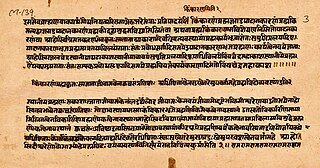
Advaita Vedanta, originally known as Puruṣavāda, is a school of Hindu philosophy, and one of the classic Indian paths to spiritual realization. The term Advaita refers to its idea that the true self, Atman, is the same as the highest metaphysical Reality (Brahman). The followers of this school are known as Advaita Vedantins, or just Advaitins, and they seek spiritual liberation through acquiring vidyā, meaning knowledge, of one's true identity as Atman, and the identity of Atman and Brahman.
Hindu philosophy refers to a group of darśanas that emerged in ancient India. These include six systems (ṣaḍdarśana) – Sankhya, Yoga, Nyaya, Vaisheshika, Mimamsa and Vedanta. These are also called the Astika (orthodox) philosophical traditions and are those that accept the Vedas as an authoritative, important source of knowledge. Ancient and medieval India was also the source of philosophies that share philosophical concepts but rejected the Vedas, and these have been called nāstika Indian philosophies. Nāstika Indian philosophies include Buddhism, Jainism, Cārvāka, Ājīvika, and others.
Avidyā is a Sanskrit word whose literal meaning is ignorance, misconceptions, misunderstandings, incorrect knowledge, and it is the opposite of Vidya. It is used extensively in Hindu texts, including the Upanishads, and in other Indian religions such as Buddhism and Jainism, particularly in the context of metaphysical reality.
Tattva is a Sanskrit word meaning 'thatness', 'principle', 'reality' or 'truth'. According to various Indian schools of philosophy, a tattva is an element or aspect of reality. In some traditions, they are conceived as an aspect of deity. Although the number of tattvas varies depending on the philosophical school, together they are thought to form the basis of all our experience. The Samkhya philosophy uses a system of 25 tattvas, while Shaivism recognises 36 tattvas. In Buddhism, the equivalent is the list of dhammas which constitute reality.

The Shvetashvatara Upanishad is an ancient Sanskrit text embedded in the Yajurveda. It is listed as number 14 in the Muktika canon of 108 Upanishads. The Upanishad contains 113 mantras or verses in six chapters.
The Samkhyakarika is the earliest surviving text of the Samkhya school of Hindu philosophy. The text's original composition date is unknown, but its terminus ad quem date has been established through its Chinese translation that became available by 569 CE. It is attributed to Ishvara Krishna.
In Kaśmir Śaivism the world is described as being composed of four spheres that contain a series of phenomenal elements (tattva). The four aṇḍa are described to appear by the means of the internal abundance of Śiva's divine powers. Outside the four aṇḍa is Śiva tattva which is the substrate and essential nature of all the other tattvas.

The tattvas in Indian philosophy are elements or principles of reality. Tattvas are the basic concepts to understand the nature of absolute, the souls and the universe in Samkhya and Shaivite philosophies. Samkhya philosophy lists 25 tattvas while later Shaivite philosophies extend the number to 36.

In Hindu philosophy, Brahman(ब्रह्म) is the material, efficient, formal and final cause of all that exists and the highest Universal Principle, the Ultimate Reality in the universe. These schools of thought also consider Brahman to be the pervasive, genderless, infinite, eternal truth and bliss which does not change, yet is the cause of all changes. Brahman as a metaphysical concept is the single binding unity behind diversity in all that exists in the universe.
The Jīva or Atman is a philosophical term used within Jainism to identify the soul. As per the Jain cosmology, jīva or soul is the principle of sentience and is one of the tattvas or one of the fundamental substances forming part of the universe. The Jain metaphysics, states Jagmanderlal Jaini, divides the universe into two independent, everlasting, co-existing and uncreated categories called the jiva (soul) and the ajiva (non-soul). This basic premise of Jainism makes it a dualistic philosophy. The jiva, according to Jainism, is an essential part of how the process of karma, rebirth and the process of liberation from rebirth works.

Pratyabhijna is an idealistic monistic and theistic school of philosophy in Kashmir Shaivism, originating in the 9th century CE. The term Trika was used by Abhinavagupta to represent the entire Kashmir Shaivism or to designate the Pratyabhijna system.

Jivatva means – the state of life or the state of the individual soul. Jivatva is the state of life of the Jiva, the living entity, which is a particular manifestation of Atman, the embodied being limited to psycho-physical states, and the source of avidya that suffers (repeated) transmigration as result of its actions. Until ignorance ceases the Jiva remains caught in experience of the results of actions bringing merit and demerit, and in the state of individuality (jivatva), and so long as the connection with the intellect as conditioning adjunct lasts, so long the individuality and transmigration of soul lasts.
Abhasavada is the term derived from the word Abhasa meaning mere or fallacious appearance, reflection, looking like, light, semblance of reason, intention. In Hindu philosophy this term refers to the Theory of Appearance, both of the Shaivite school and the Advaita Vedanta, though with differing connotations.

Pratibimbavada or the theory of reflection, whose origin can be traced to the Brahma Sutra II.iii.50, is credited to Padmapada, the founder of the Vivarna School of Advaita Vedanta and the author of Pancapadika which is a commentary on Sankara’s Brahma Sutra Bhasya. According to the Vivarna School, Brahman is the locus of Avidya, and which, with regard to the relation existing between the Jiva and Brahman, concludes that the Jiva is a mere reflection (pratibimba) of its prototype (bimba) i.e. of Brahman, and therefore, identical with its essence, Brahman. This school holds the view that the mahavakya, tat tvam asi, is sufficient for the attainment of enlightenment, of the realization of the identity between the self and Reality.

Taijasa, which means endowed with light, is one of the many different levels of existence which the Jiva experiences due to the activity of Maya; it is the second of the three stages of consciousness that are part of the individual order of the Jiva. The three stages of consciousness are – 1) Vishva or Vaisvanara or the waking stage characterized by the individual gross body or sthula-sarira, 2) Taijasa or the dream consciousness which has the subtle body or suksma-sarira as its object, and 3) Prajna or the deep sleep consciousness which is the unified undifferentiated consciousness or prajanaaghana and the characteristic of the blissful causal body, the ultimate experience of Brahman.

Pradhāna is an adjective meaning – most important, prime, chief or major. The Shatapatha Brahmana gives its meaning as – 'the chief cause of the material nature' (S.B.7.15.27) or 'the creative principle of nature' (S.B.10.85.3). The Samkhya School of Indian philosophy employs the word, Pradhana, to mean the creative principle of nature, as the original root of matter, the Prime Matter but which according to Badarayana’s logic is the unintelligent principle which cannot be the one consisting of bliss.

Idam(Tamil) is a Tamil/Sanskrit word which denotes location or position or place. In grammar it is used at the beginning or middle of a sentence as a nominative or attributive pronoun, combined with or without ya, adds emphasis to other nouns, propositions etc.; and means - this, here or yonder, present or seen nearby, fit for, or without reference to noun refers to एतद् ('that') or to what precedes.
Abhimāna (Sanskrit:अभिमान) variously means – pride, false prestige, desire, an impression, the conception, by self-conception, from the misconception; in Hindu philosophy, it means – prideful attachment of "I-sense" i.e. man + māna ; it also means – identify or identification and also refers to selfish conviction, for abhimāna is the function of ahamkara (ego) as the state of mind which interprets experience as " mine ".

The Trishikhibrahmana Upanishad, also known as Trisikhibrahmanopanisad, is one of the minor Upanishads of Hinduism and a Sanskrit text. It is attached to the Shukla Yajurveda and is classified as one of the 20 Yoga Upanishads.
Jaideva Singh was an Indian musicologist and philosopher. He played a key role in the development of All India Radio where he was chief producer. He was influenced by the Indian musicologist Vishnu Narayan Bhatkhande.
Motilal Banarsidass (MLBD) is a leading Indian publishing house on Sanskrit and Indology since 1903, located in Delhi, India. It publishes and distributes serials, monographs, and scholarly publications on Asian religion, philosophy, history, culture, arts, architecture, archaeology, language, literature, linguistics, musicology, mysticism, yoga, tantra, occult, medicine, astronomy, astrology and other related subjects, and to date have published over 25,000 works.
Sir John George Woodroffe (1865–1936), also known by his pseudonym Arthur Avalon, was a British Orientalist whose work helped to unleash in the West a deep and wide interest in Hindu philosophy and Yogic practices.








